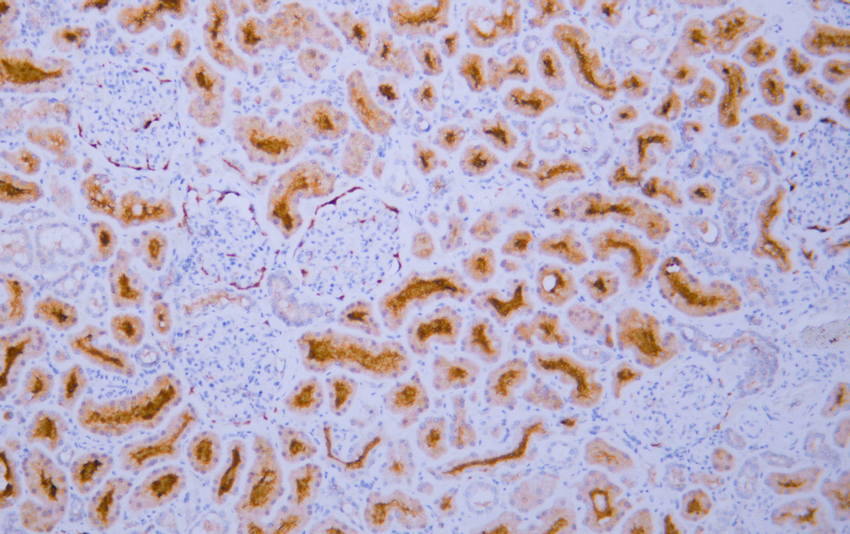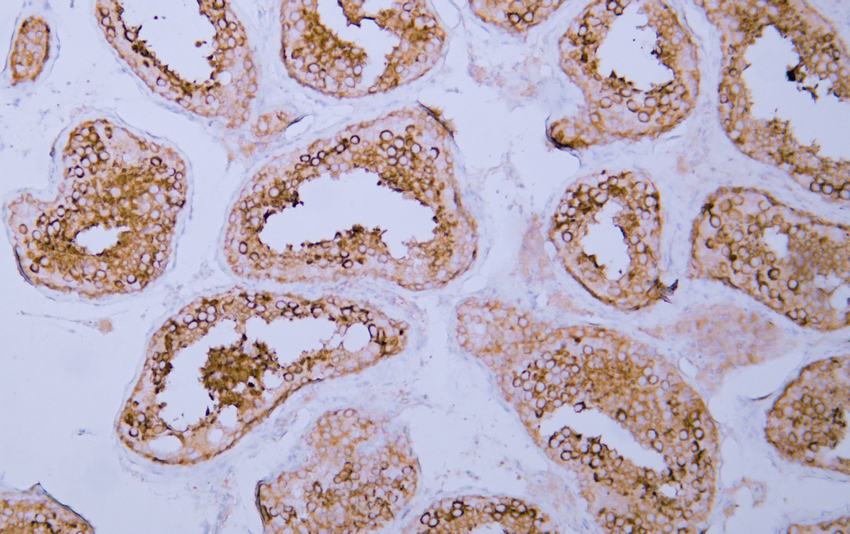HDAC6 (ABT-HDAC6) mouse mAb
- Catalog No.:YM6120
- Applications:IHC;ELISA
- Reactivity:Human;Mouse;
- Target:
- HDAC6
- Fields:
- >>Neutrophil extracellular trap formation;>>Amyotrophic lateral sclerosis;>>Alcoholism;>>Viral carcinogenesis
- Gene Name:
- HDAC6 KIAA0901 JM21
- Protein Name:
- Histone deacetylase 6 (HD6) (EC 3.5.1.98)
- Human Gene Id:
- 10013
- Human Swiss Prot No:
- Q9UBN7
- Immunogen:
- Synthesized peptide derived from human HDAC6 AA range: 1100-1215
- Specificity:
- The antibody can specifically recognize human HDAC6 protein.
- Formulation:
- PBS, 50% glycerol, 0.05% Proclin 300, 0.05%BSA
- Source:
- Mouse, Monoclonal/IgG1, kappa
- Dilution:
- IHC 1:200-400. ELISA 1:500-5000
- Purification:
- The antibody was affinity-purified from ascites by affinity-chromatography using specific immunogen.
- Storage Stability:
- -15°C to -25°C/1 year(Do not lower than -25°C)
- Molecular Weight(Da):
- 131kD
- Observed Band(KD):
- 130180kD
- Background:
- Histones play a critical role in transcriptional regulation, cell cycle progression, and developmental events. Histone acetylation/deacetylation alters chromosome structure and affects transcription factor access to DNA. The protein encoded by this gene belongs to class II of the histone deacetylase/acuc/apha family. It contains an internal duplication of two catalytic domains which appear to function independently of each other. This protein possesses histone deacetylase activity and represses transcription. [provided by RefSeq, Jul 2008],
- Function:
- catalytic activity:Hydrolysis of an N(6)-acetyl-lysine residue of a histone to yield a deacetylated histone.,function:Responsible for the deacetylation of lysine residues on the N-terminal part of the core histones (H2A, H2B, H3 and H4). Histone deacetylation gives a tag for epigenetic repression and plays an important role in transcriptional regulation, cell cycle progression and developmental events. Histone deacetylases act via the formation of large multiprotein complexes (By similarity). Plays a central role in microtubule-dependent cell motility via deacetylation of tubulin.,PTM:Sumoylated in vitro.,PTM:Ubiquitinated. Its polyubiquitination however does not lead to its degradation.,similarity:Belongs to the histone deacetylase family. Type 2 subfamily.,similarity:Contains 1 UBP-type zinc finger.,subcellular location:It is mainly cytoplasmic, where it is associated with microtubules
- Subcellular Location:
- Cytoplasmic
- Expression:
- Brain,Epithelium,Kidney,Muscle,Ovary,Placenta,
- June 19-2018
- WESTERN IMMUNOBLOTTING PROTOCOL
- June 19-2018
- IMMUNOHISTOCHEMISTRY-PARAFFIN PROTOCOL
- June 19-2018
- IMMUNOFLUORESCENCE PROTOCOL
- September 08-2020
- FLOW-CYTOMEYRT-PROTOCOL
- May 20-2022
- Cell-Based ELISA│解您多样本WB检测之困扰
- July 13-2018
- CELL-BASED-ELISA-PROTOCOL-FOR-ACETYL-PROTEIN
- July 13-2018
- CELL-BASED-ELISA-PROTOCOL-FOR-PHOSPHO-PROTEIN
- July 13-2018
- Antibody-FAQs
- Products Images

- Human kidney tissue was stained with Anti-HDAC6 (ABT-HDAC6) Antibody

- Human kidney tissue was stained with Anti-HDAC6 (ABT-HDAC6) Antibody

- Human testis tissue was stained with Anti-HDAC6 (ABT-HDAC6) Antibody



